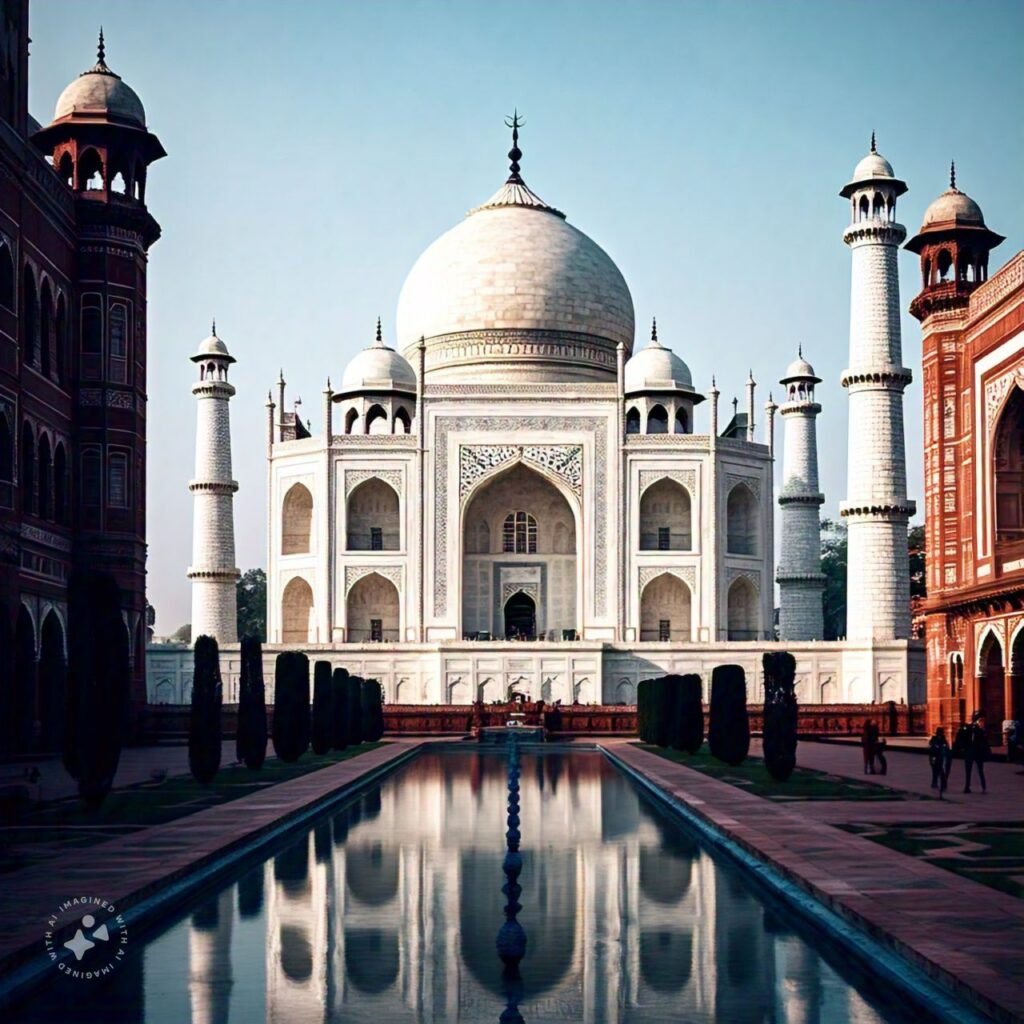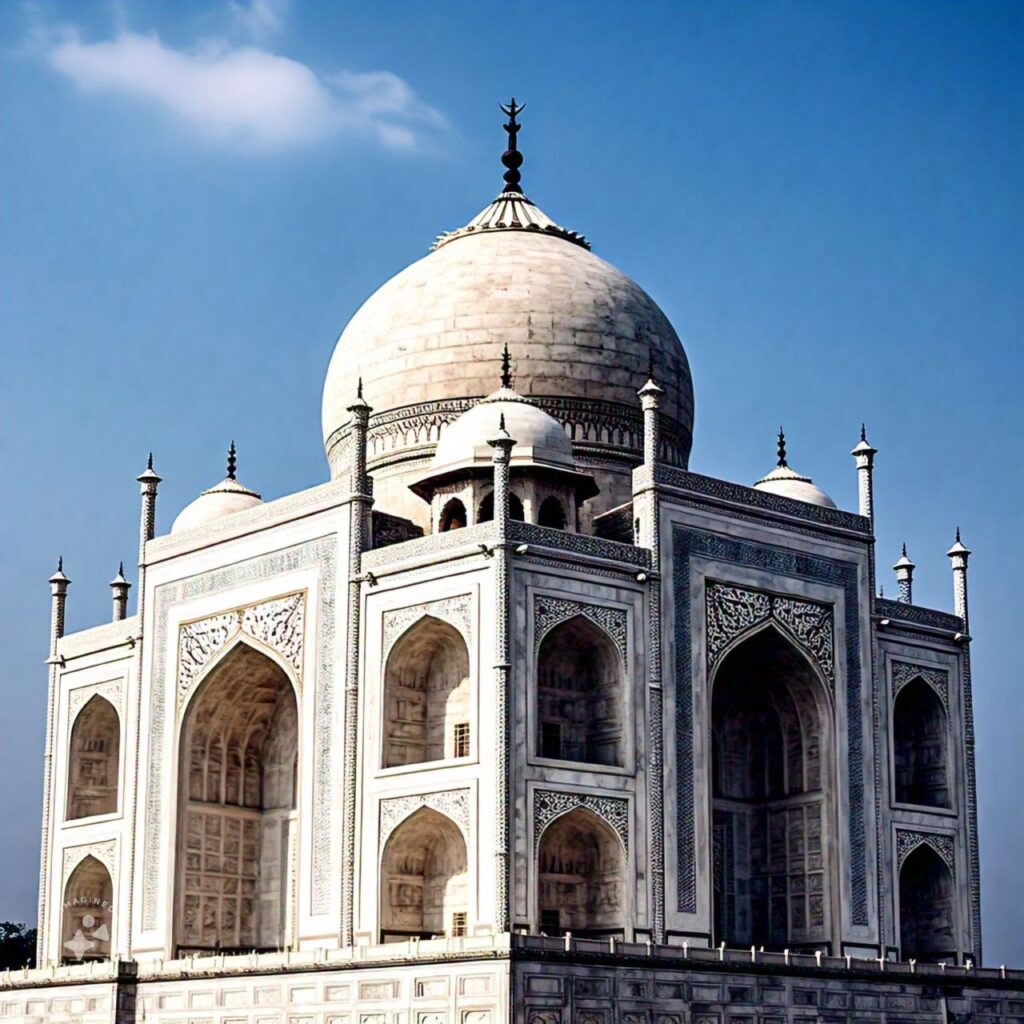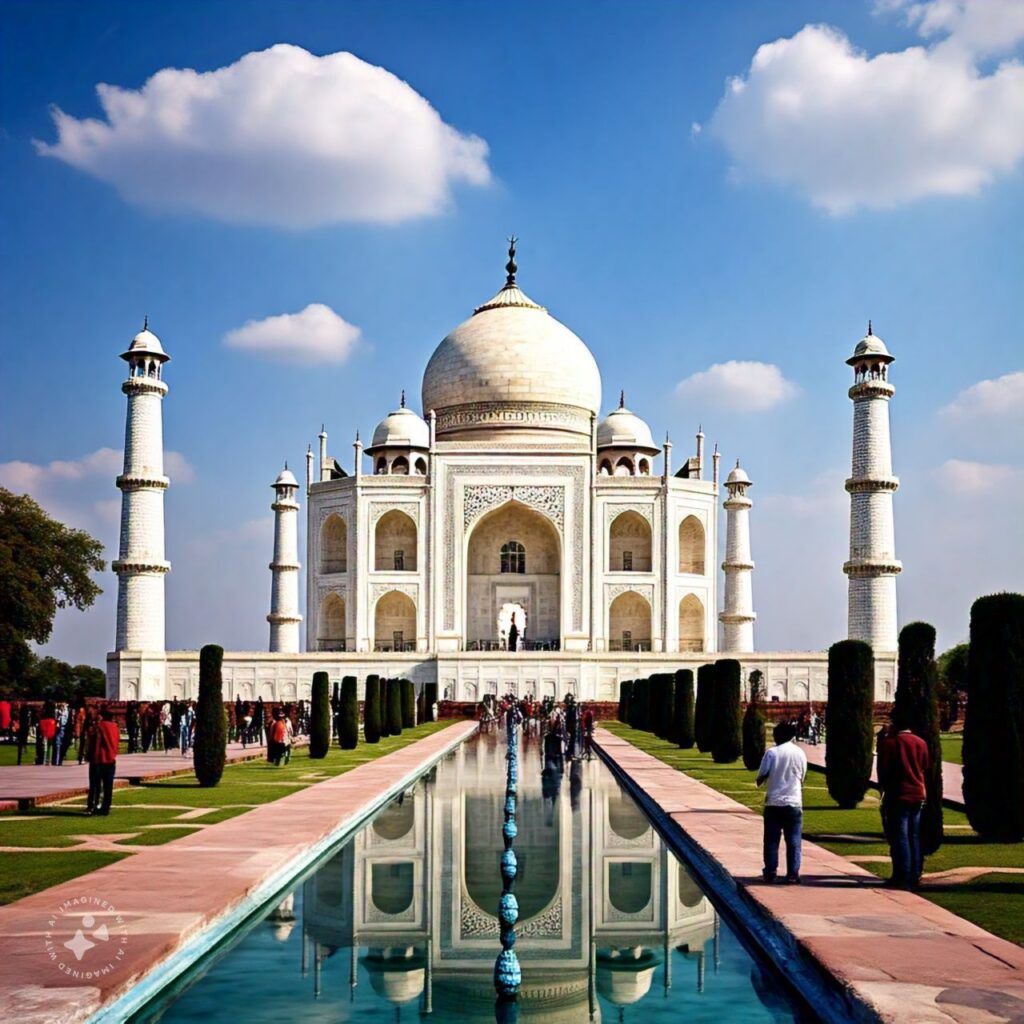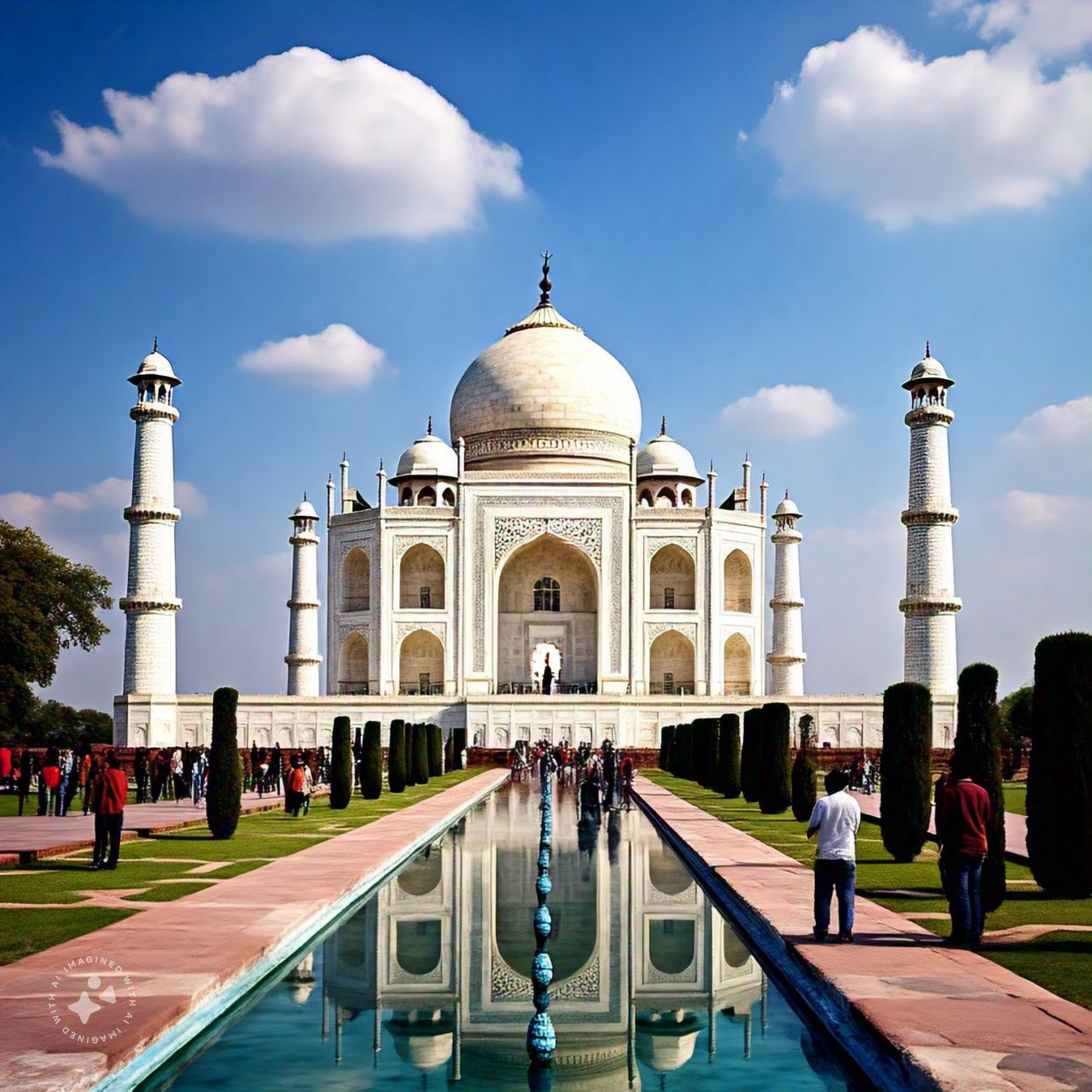The Taj Mahal, often referred to as the “Jewel of Muslim Art in India” and one of the Seven Wonders of the World, is not just an architectural marvel but also a poignant testament to eternal love. Located in Agra, Uttar Pradesh, this breathtaking white marble mausoleum is considered one of the most beautiful buildings in the world. Its intricate design, grandeur, and romantic backstory have made it an enduring symbol of love, devotion, and human creativity.
In this article, we will explore the history, architecture, cultural significance, and enduring legacy of the Taj Mahal.

A Story of Love: The Inspiration Behind the Taj Mahal
The creation of the Taj Mahal was inspired by a profound love story between Emperor Shah Jahan and his beloved wife Mumtaz Mahal. Mumtaz, the emperor’s third wife and the love of his life, died in 1631 during the birth of their 14th child. Her death left Shah Jahan devastated, and he vowed to build the most magnificent tomb for her, a tomb that would immortalize their love and serve as a symbol of their eternal bond.
Shah Jahan’s grief and deep affection for Mumtaz Mahal became the driving force behind the construction of the Taj Mahal. In fact, he even named the mausoleum “Taj Mahal,” which is thought to be derived from the Persian word “Mumtaz Mahal” (meaning “Exalted One of the Palace”). The emperor’s love and dedication to his wife were expressed through the sheer grandeur and beauty of the structure that he commissioned to honor her memory.
The Construction of the Taj Mahal
Construction of the Taj Mahal began in 1632, one year after Mumtaz Mahal’s death, and continued for 22 years until its completion in 1653. The design of the monument was a collaborative effort, with a team of skilled artisans, architects, and craftsmen from across India and the wider Mughal Empire working under the supervision of the emperor’s trusted advisor, Ustad Ahmad Lahauri. It is believed that around 20,000 workers were involved in the construction of the Taj Mahal, and materials were sourced from various parts of India, Asia, and even Europe.
The Taj Mahal is an exquisite example of Mughal architecture, which blends elements from Islamic, Persian, Ottoman Turkish, and Indian architectural styles. The monument is built primarily from white marble, which was sourced from the famous Makrana quarries in Rajasthan. The marble is intricately inlaid with precious stones, creating elaborate floral patterns and geometric designs that add to the building’s ethereal beauty.
The central tomb, which houses the remains of Mumtaz Mahal, is flanked by a symmetrical layout of gardens, pathways, and water channels, creating a serene and harmonious atmosphere. The Taj Mahal complex also includes a mosque and a guest house, both of which are constructed from red sandstone, providing a striking contrast to the white marble tomb.

The Architecture of the Taj Mahal
The Taj Mahal’s design is a harmonious blend of symmetry, grandeur, and delicate artistry. The entire structure is based on an eightfold pattern, with the tomb at the center. This central tomb is topped by a majestic dome, which is approximately 35 meters (115 feet) high. The dome’s graceful curve, along with the four minarets at each corner of the platform, creates a sense of balance and harmony, symbolizing the unity of heaven and earth.
The tomb’s inner chamber contains the cenotaphs of Mumtaz Mahal and Shah Jahan. Interestingly, while the cenotaphs are intricately decorated and placed in the center of the chamber, the actual graves are located in a lower crypt beneath the tomb. The entire inner chamber is adorned with fine marble latticework, semi-precious stones, and exquisite carvings that depict Islamic motifs, flowers, and geometric patterns.
The charbagh garden, which surrounds the Taj Mahal, is designed in the traditional Mughal style, representing an earthly replica of paradise. The garden is divided into four parts by walkways and water channels, symbolizing the rivers of paradise. The symmetry of the entire site reflects the grandeur and perfection of the Mughal Empire at its height.
One of the most striking features of the Taj Mahal is its ability to change in appearance throughout the day. The monument appears to shift in color, depending on the time of day and the lighting conditions. In the early morning, the Taj Mahal glows with a soft, pink hue. During the day, the white marble sparkles in the sunlight, while at night, under the moonlight, it takes on a silvery, almost ethereal quality. This ability to transform in different lights adds to the monument’s mystique and beauty, reinforcing its reputation as a timeless symbol of love.
Symbolism of the Taj Mahal
The Taj Mahal is more than just an architectural marvel; it is a powerful symbol of love, loss, and devotion. Shah Jahan’s efforts to build the Taj Mahal were driven by his desire to preserve the memory of his wife and the love they shared. The monument’s architecture, with its symmetrical design, intricate carvings, and delicate inlay work, reflects the emperor’s reverence for Mumtaz Mahal and his determination to create a structure that would stand the test of time as a tribute to her.
The Taj Mahal’s garden is also symbolic of paradise, representing an ideal world where the soul of Mumtaz Mahal is at peace. The flowing water channels in the garden represent the rivers of life, and the flowers and trees symbolize the beauty of nature. The tomb itself, as a serene resting place, signifies the eternal union between the earthly and the divine.
As a UNESCO World Heritage Site, the Taj Mahal has been recognized not only for its historical and cultural significance but also for its universal message of love and devotion. It continues to inspire millions of visitors who come to witness its unparalleled beauty and the profound emotion behind its creation.

The Taj Mahal’s Legacy and Cultural Importance
The Taj Mahal has long been a symbol of India’s rich cultural and architectural heritage. It represents the pinnacle of Mughal architecture and is a reflection of the empire’s artistic, engineering, and philosophical achievements. The monument is often regarded as one of the finest examples of Islamic architecture, demonstrating the empire’s ability to blend artistic expression with engineering ingenuity.
Over the years, the Taj Mahal has become one of the most recognized and admired landmarks in the world. It attracts millions of visitors each year, making it one of India’s top tourist destinations. The monument has also been featured in numerous films, books, and works of art, further cementing its place as a symbol of love and human creativity.
In addition to its cultural significance, the Taj Mahal is also an important reminder of India’s rich history and the legacy of the Mughal Empire. It represents an era of prosperity, innovation, and cultural exchange, and its continued preservation is vital for future generations to experience and appreciate its beauty and historical importance.
Challenges and Preservation Efforts
Over the years, the Taj Mahal has faced a number of challenges. Pollution, natural weathering, and the immense number of visitors have caused some deterioration to the monument. The white marble, which is prone to discoloration, has suffered from the effects of air pollution and grime, particularly from the nearby industrial activities. In response, the Indian government has taken various measures to protect and preserve the Taj Mahal, including air quality control measures and periodic restoration projects.
Additionally, efforts have been made to control the number of tourists entering the monument to ensure the preservation of its structure and beauty. These efforts aim to balance the growing demand for tourism with the need for conservation.
Conclusion: The Eternal Symbol of Love
The Taj Mahal stands as one of the world’s greatest architectural masterpieces, a testament to the power of love and the enduring legacy of the Mughal Empire. It continues to captivate and inspire people from all over the world, drawing visitors to witness its breathtaking beauty and to reflect on the profound story of love that lies behind its creation.
As both a symbol of the love between Shah Jahan and Mumtaz Mahal and an enduring cultural icon, the Taj Mahal is more than just a mausoleum. It is a masterpiece that represents the pinnacle of human emotion, artistic creativity, and architectural innovation—a timeless tribute to the eternal bond between two souls.
